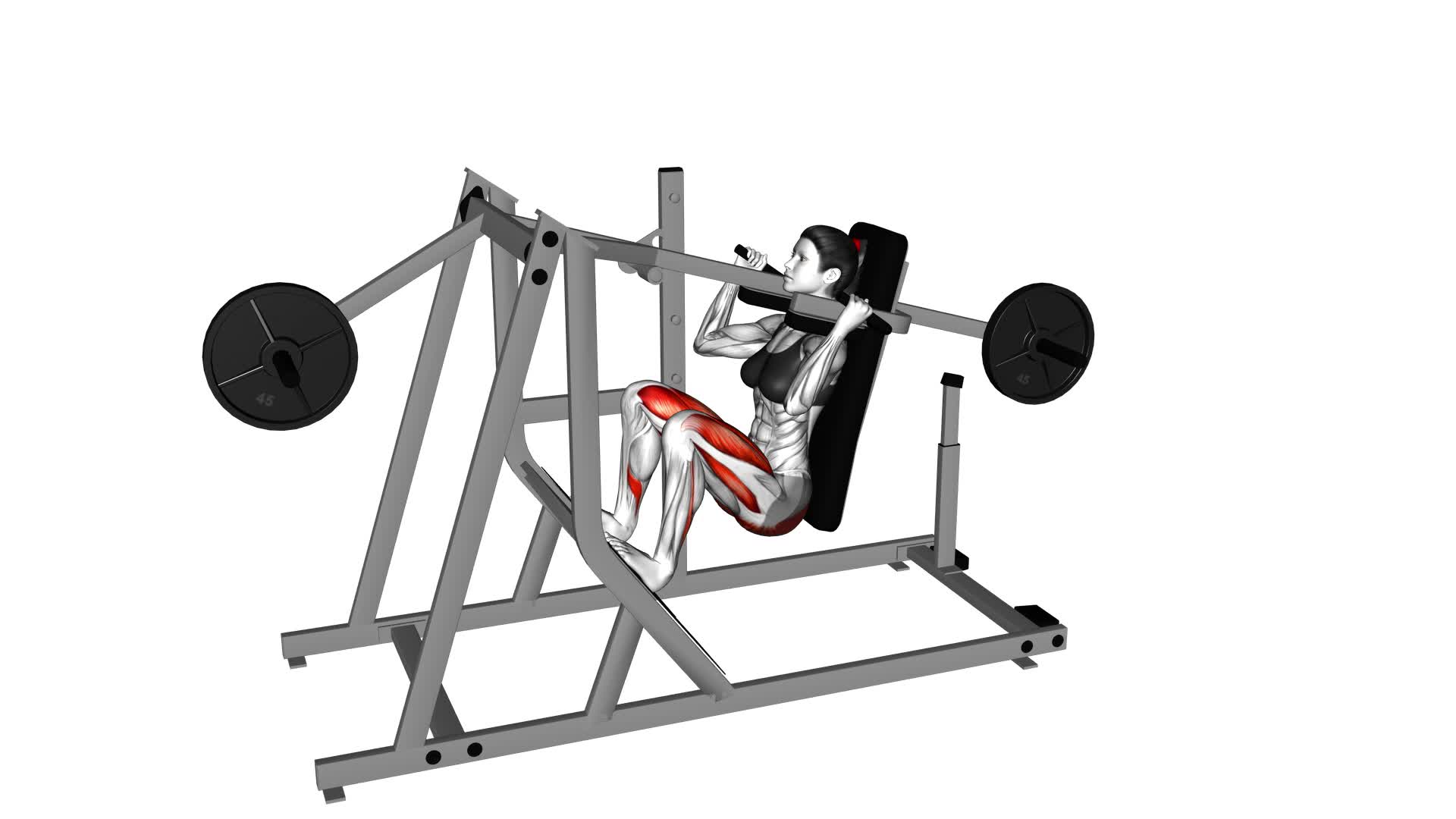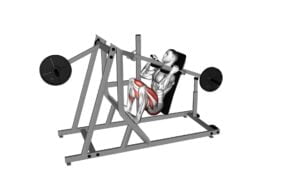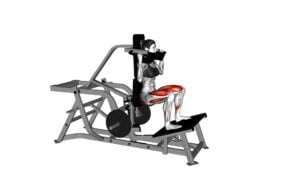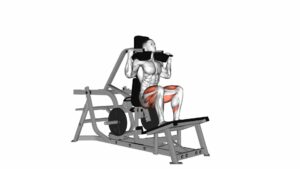Lever Pendulum Squat (Plate Loaded) (Female) – Video Exercise Guide & Tips

Get ready to tone and strengthen your legs with the lever pendulum squat! This video exercise guide is designed specifically for females, providing step-by-step instructions and valuable tips to help you maximize your results.
Watch This Exercise Video
Learn the proper set-up and equipment needed to perform this plate loaded exercise, and avoid common mistakes along the way.
Get ready to take your squatting game to the next level and achieve your fitness goals with the lever pendulum squat.
Let's do this!
Key Takeaways
- Lever Pendulum Squat is beneficial for females as it enhances strength and stability.
- Proper foot placement in Lever Pendulum Squat affects muscle activation and targeting.
- Engaging core muscles during the exercise improves overall strength and balance.
- Following proper breathing technique and maximizing results through consistency and progressive overload are important for optimal outcomes.
Benefits of Lever Pendulum Squat for Females
Experience the unique benefits of the Lever Pendulum Squat to enhance your strength and stability as a female athlete. This exercise is specifically designed to target your leg muscles and improve stability. By incorporating the Lever Pendulum Squat into your training routine, you can effectively increase leg strength and develop a solid foundation for athletic performance.
The Lever Pendulum Squat is a plate-loaded exercise that allows you to load weight onto the machine, providing resistance for your leg muscles. As you perform the squatting motion, the lever arm moves in a controlled arc, mimicking the natural movement of your body. This helps to activate your lower body muscles, including the quadriceps, hamstrings, and glutes, while also engaging your core for stability.
One of the key benefits of the Lever Pendulum Squat is its ability to improve stability. The controlled movement of the lever arm forces you to stabilize your body throughout the exercise, which strengthens the muscles responsible for balance and coordination. As a result, you'll not only increase your leg strength but also enhance your overall stability, reducing the risk of injuries during sports and other physical activities.
Now that you understand the benefits of the Lever Pendulum Squat, it's important to learn about the proper set-up and equipment for this exercise.
Proper Set-up and Equipment for Lever Pendulum Squat
To properly set up and perform the Lever Pendulum Squat, you'll need the appropriate equipment and follow these guidelines:
- Equipment:
- Lever Pendulum Squat machine: This specialized piece of equipment is designed to target your lower body muscles effectively. It consists of a lever arm that's attached to a weight stack, allowing you to adjust the resistance according to your fitness level.
- Weight plates: The Lever Pendulum Squat machine requires weight plates to provide the necessary resistance for the exercise. Start with a weight that challenges you but still allows you to maintain proper form.
- Safety pins: These are essential for adjusting the height of the lever arm, ensuring that you can perform the exercise comfortably and safely.
- Lever Pendulum Squat techniques:
- Stand in the machine with your feet shoulder-width apart and your toes slightly turned out.
- Grab the handles for stability and support.
- Lower your body by bending your knees and hips, keeping your chest up and your back straight.
- Push through your heels to extend your legs and return to the starting position.
- Lever Pendulum Squat variations:
- Single-leg Lever Pendulum Squat: Perform the exercise with one leg at a time to increase the challenge and target each leg individually.
- Explosive Lever Pendulum Squat: Add explosive power to the exercise by performing it with quick, controlled movements. This variation helps improve your speed and power.
Now that you understand the proper set-up and equipment required for the Lever Pendulum Squat, let's move on to the step-by-step guide to performing the exercise.
Step-by-Step Guide to Performing Lever Pendulum Squat
To perform the Lever Pendulum Squat, follow these step-by-step instructions.
First, stand with your feet shoulder-width apart and position yourself in the lever pendulum squat machine. Adjust the seat so that your knees are aligned with the pivot point of the machine. Grasp the handles on either side of the seat for stability.
Next, unlock the weight by pushing the lever forward. This will allow the weight to swing freely. As you inhale, lower your body into a squat position by bending your knees and hips. Keep your chest up and back straight throughout the movement.
Once you reach a comfortable depth, exhale and push through your heels to extend your knees and hips, returning to the starting position. Make sure to maintain control of the weight and avoid excessive swinging or bouncing.
Variations of the lever pendulum squat can include adjusting the weight load or using different foot positions to target different muscle groups. The lever pendulum squat primarily targets the quadriceps, hamstrings, and glutes. It also engages the core muscles for stability.
Remember to always use proper form and start with lighter weights before progressing to heavier loads. As with any exercise, consult with a fitness professional if you have any concerns or questions about your technique.
Common Mistakes to Avoid During Lever Pendulum Squat
To avoid common mistakes during the Lever Pendulum Squat, focus on maintaining proper form and control throughout the movement. Here are three important tips to keep in mind:
- Avoiding Injuries:
- One common mistake is going too heavy with the weight, which can put unnecessary strain on your joints and increase the risk of injury.
- Start with a weight that allows you to perform the exercise with proper form and gradually increase the load as you become more comfortable and stronger.
- Additionally, make sure to warm up properly before starting the exercise to prepare your muscles and joints for the movement.
- Modifications for Different Fitness Levels:
- Another mistake to avoid isn't modifying the exercise based on your fitness level.
- If you're a beginner, it's recommended to start with bodyweight squats or using lighter weights to build strength and proper technique.
- As you progress, you can gradually increase the weight and intensity.
- Remember, it's important to listen to your body and only progress when you're ready.
- Control and Range of Motion:
- One crucial aspect of the Lever Pendulum Squat is maintaining control throughout the movement.
- Avoid rushing through the exercise or using momentum to lift the weight.
- Instead, focus on a slow and controlled descent, ensuring that your knees are tracking in line with your toes and maintaining a proper range of motion.
- This will help engage the targeted muscles effectively and reduce the risk of injury.
Tips for Maximizing Your Results With Lever Pendulum Squat
To maximize your results with the Lever Pendulum Squat, consistently focus on maintaining proper form and control throughout the exercise. Proper form is crucial for targeting the correct muscles and preventing injury.
One way to modify the Lever Pendulum Squat is by adjusting the weight load. Start with a weight that challenges you, but allows you to maintain proper form. As you progress, gradually increase the weight to continue challenging your muscles.
Another way to modify the exercise is by adjusting the foot placement. Placing your feet wider apart targets the glutes and inner thighs, while placing them closer together targets the quads. Experiment with different foot positions to find what works best for you.
It's also important to engage your core muscles throughout the exercise. This helps stabilize your body and maintain proper form.
Lastly, remember to breathe. Inhale as you lower your body and exhale as you push back up.
Following these tips will help you maximize your results with the Lever Pendulum Squat.
Frequently Asked Questions
How Much Weight Should I Use When Performing the Lever Pendulum Squat?
When performing the lever pendulum squat, it's important to choose an appropriate weight that challenges you but allows for proper form. The weight you use will depend on your strength and fitness level.
Start with a lighter weight and gradually increase it as you become more comfortable and confident with the exercise.
The lever pendulum squat is a great alternative squat variation that targets your lower body muscles, helping to improve lower body strength and stability.
Can Men Also Perform the Lever Pendulum Squat Exercise?
Yes, men can also perform the lever pendulum squat exercise. This exercise offers several benefits for men, including targeting the quadriceps, hamstrings, and glutes for stronger and more defined legs.
It also helps improve overall lower body strength, stability, and balance. Incorporating the lever pendulum squat into your workout routine can enhance your performance in other exercises and sports activities.
Make sure to use proper form and start with a weight that challenges you but allows for proper execution.
Is It Necessary to Warm up Before Doing the Lever Pendulum Squat?
Before starting the lever pendulum squat, it's important to warm up to prevent injury and improve performance. Warming up helps increase blood flow to your muscles, making them more flexible and ready for the exercise. It also prepares your joints and ligaments for the movements involved.
Remember to avoid common mistakes like using too much weight or rounding your back. Take your time, focus on form, and gradually increase the intensity as you get comfortable with the exercise.
Are There Any Alternative Exercises That Target Similar Muscle Groups as the Lever Pendulum Squat?
If you're looking for alternative exercises that target similar muscle groups as the lever pendulum squat, there are a few options you can try.
Lunges are a great choice, as they work the quads, glutes, and hamstrings.
Step-ups are another effective exercise that targets the same muscle groups.
Bulgarian split squats are also worth considering, as they engage the lower body muscles in a similar way.
Incorporating these exercises into your routine can help you achieve the same muscle group targeting as the lever pendulum squat.
How Often Should I Include the Lever Pendulum Squat in My Workout Routine to See Results?
To see results from the lever pendulum squat, you should include it in your workout routine at least 2-3 times a week. This exercise targets your leg muscles, specifically the quadriceps, hamstrings, and glutes.
The lever pendulum squat offers benefits such as increasing lower body strength, improving stability, and enhancing overall leg development.
To add variation, you can try using different foot positions or adding resistance by using heavier plates.
Conclusion
In conclusion, the Lever Pendulum Squat is a highly effective exercise for females looking to strengthen their lower body. It offers numerous benefits, including improved muscle tone, increased strength, and enhanced balance.
By following the proper set-up and using the right equipment, females can perform this exercise with ease. Avoiding common mistakes and implementing the provided tips will help maximize results.
Incorporating the Lever Pendulum Squat into your workout routine will undoubtedly yield positive outcomes for your fitness goals.

Author
Years ago, the spark of my life’s passion ignited in my mind the moment I stepped into the local gym for the first time. The inaugural bead of perspiration, the initial endeavor, the very first surge of endorphins, and a sense of pride that washed over me post-workout marked the beginning of my deep-seated interest in strength sports, fitness, and sports nutrition. This very curiosity blossomed rapidly into a profound fascination, propelling me to earn a Master’s degree in Physical Education from the Academy of Physical Education in Krakow, followed by a Sports Manager diploma from the Jagiellonian University. My journey of growth led me to gain more specialized qualifications, such as being a certified personal trainer with a focus on sports dietetics, a lifeguard, and an instructor for wellness and corrective gymnastics. Theoretical knowledge paired seamlessly with practical experience, reinforcing my belief that the transformation of individuals under my guidance was also a reflection of my personal growth. This belief holds true even today. Each day, I strive to push the boundaries and explore new realms. These realms gently elevate me to greater heights. The unique combination of passion for my field and the continuous quest for growth fuels my drive to break new ground.







